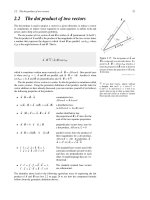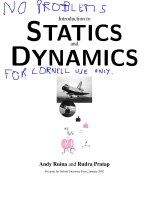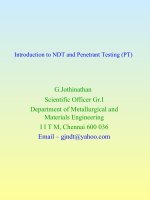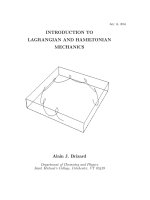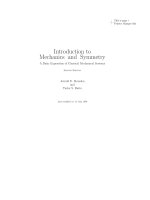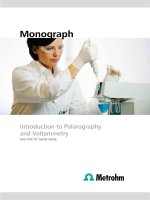introduction to cell and tissue culture
Bạn đang xem bản rút gọn của tài liệu. Xem và tải ngay bản đầy đủ của tài liệu tại đây (4.08 MB, 314 trang )
Introduction to Cell and
Tissue Culture
Theory and Technique
huangzhiman 2002.12.18
Foreword
Chapter 1: Introduction
1
Chapter 2: Setting Up a Cell Culture Laboratory
9
Chapter 3: The Physical Environment
25
Chapter 4: Media
41
Chapter 5: Standard Cell Culture Techniques
63
Chapter 6: Looking at Cells
89
Chapter 7: Contamination: How to Avoid It, Recognize It, and Get Rid of It 117
Chapter 8: Serum-Free Culture
129
Chapter 9: Primary Cultures
151
Chapter 10: Establishing a Cell Line
165
Chapter 11: Special Growth Conditions
175
Chapter 12: Cell Culture for Commercial Settings
195
Glossary Appendix Index
205
Page i
Introduction to Cell and Tissue Culture
Theory and Technique
Page ii
INTRODUCTORY CELL AND MOLECULAR BIOLOGY TECHNIQUES
SERIES EDITOR: Bonnie S. Dunbar, Baylor College of Medicine, Houston, Texas
INTRODUCTION TO CELL AND TISSUE CULTURE: Theory and Technique
Jennie P. Mather and Penelope E. Roberts
Page iii
Introduction to Cell and Tissue Culture
Theory and Technique
Jennie P. Mather and
Penelope E. Roberts
Genentech Inc.
South San Francisco, California
Page iv
Library of Congress Cataloging-in-Publication Data
Mather, Jennie P., 1948¨C
Introduction to cell and tissue culture : theory and technique /
Jennie P. Mather and Penelope E. Roberts.
p. cm.¡ª (Introductory cell and molecular biology
techniques)
Includes bibliographical references and index.
ISBN 0-306-45859-4
1. Cell culture. 2. Tissue culture. I. Roberts, Penelope E.
II. Title. III. Series.
[DNLM: 1. Tissue Culture¡ªmethods. 2. Microbiological Techniques.
QS 525M427i 1998]
QH585.2.M38 1998
571.5'38¡ªdc21
DNLM/DLC
for Library of Congress 98-27597
CIP
ISBN 0-306-45859-4
©1998 Plenum Press, New York
A Division of Plenum Publishing Corporation
233 Spring Street, New York, N.Y. 10013
10 9 8 7 6 5 4 3 2 1
All rights reserved
No part of this book may be reproduced, stored in a retrieval system, or transmitted in any form or by
any means, electronic, mechanical, photocopying, microfilming, recording, or otherwise, without written
permission from the Publisher
Printed in the United States of America
Page v
To the memory of Dr. Izumi Hayashi,
whose life was as elegant as her experiments
Page vii
Foreword
It is a pleasure to contribute the foreword to Introduction to Cell and Tissue Culture: Theory and
Techniques by Mather and Roberts. Despite the occasional appearance of thoughtful works devoted to
elementary or advanced cell culture methodology, a place remains for a comprehensive and definitive
volume that can be used to advantage by both the novice and the expert in the field. In this book, Mather
and Roberts present the relevant methodology within a conceptual framework of cell biology, genetics,
nutrition, endocrinology, and physiology that renders technical cell culture information in a
comprehensive, logical format. This allows topics to be presented with an emphasis on troubleshooting
problems from a basis of understanding the underlying theory.
The material is presented in a way that is adaptable to student use in formal courses; it also should be
functional when used on a daily basis by professional cell culturists in academia and industry. The
volume includes references to relevant Internet sites and other useful sources of information. In addition
to the fundamentals, attention is also given to modem applications and approaches to cell culture
derivation, medium formulation, culture scale-up, and biotechnology, presented by scientists who are
pioneers in these areas. With this volume, it should be possible to establish and maintain a cell culture
laboratory devoted to any of the many disciplines to which cell culture methodology is applicable.
DR. DAVID BARNES
DEPARTMENT OF BIOCHEMISTRY AND BIOPHYSICS
OREGON STATE UNIVERSITY
Page ix
Acknowledgments
We would like to thank Dr. David Phillips for all we have learned about looking at cells during many
years of collaboration. Thanks also to Dr. Phillips for providing the scanning and transmission electron
micrographs used throughout the book. Our thanks to Dr. David Barnes for many interesting discussions
on the nature of cells, from worms to man, over many years. We would also like to thank Dr. Barnes,
Dr. Monique LeFleur, Amy McMurtry, and Patricia Kaminsky for their careful reading of draft versions
of the volume and their suggestions for corrections and clarifications. We would also like to thank
Aldona Kallok for helping in many ways with the preparation of the manuscript.
We would also especially like to thank Alicia Byer, Dr. Lin-Zhi Zhuang, Dr. Virgilio Perez-Infante,
Mary Tsao, Robert Shawley, Diana Stocks, Dr. Margaret Roy, Dr. Yossi Orly, Dr. Teresa Woodruff, Dr.
Alison Moore, Dr. Rong-hao Li, Dr. Jean-Philippe Stephan, Dr. Vidya Sundaresan, Terri Restivo,
Marcel Zocher, Kathy King, Glynis McCray, and the other past and present members of our laboratory.
It is impossible to overestimate the contributions of these friends and colleagues who have, in the course
of their work and studies in the Mather Laboratories over the years, added greatly to our knowledge and
the fun of cell culture. Finally, we would like to thank Dr. Gordon Sato, who introduced us to the joy of
cell culture and the infinite variety of interesting things to do with cells.
A note on the figures: The graphs and tables presented throughout the book are drawn from actual
experimental data generated in the Mather Laboratories over the last 20 years. We have chosen those
experiments that best illustrate the point being discussed in the text and have not necessarily provided all
the experimental details for each figure.
We would also like to thank the following vendors for their help in discussions of their equipment and,
where noted, in providing photographs or data for the figures and tables: James Quach, Instrument
Services, Genentech, BRL Life Technologies, Corning Corporation, Falcon (Becton Dickinson), The
Baker Company, Mike Alden of Coulter Electronics, E. Braun Biotech International, The Edge
Scientific Instrument Co., Altair Gases, Sara Ferrer and Technical Instrument Company, and Brent
Kolhede of Lab Equipment Company.
Page xi
Contents
Chapter 1: Introduction 1
The History of Tissue and Organ Culture 1
The Practice and Theory of Tissue Culture 3
Primary Culture 4
Established Cell Lines 6
The Physical and Chemical Environment 6
Complex versus Defined Culture Environments 7
Further Information 7
References 8
Chapter 2: Setting Up a Cell Culture Laboratory
9
Space Requirements 9
Equipment 11
The Teaching Laboratory 11
The Standard Tissue Culture Laboratory 13
The Optimal Tissue Culture Laboratory 19
Plasticware and Glassware 20
Maintaining the Laboratory 21
Daily Tasks 21
Weekly Tasks 23
Monthly Tasks 23
Chapter 3: The Physical Environment
25
Temperature 25
pH 28
Osmolality 30
Page xii
CO
2
, Oxygen, and Other Gases 31
Surfaces and Cell Shape 32
Adherent versus Nonadherent Cells 33
Plastic¡ªDifferent Types for Different Purposes 34
Glass 35
Cell Shape 36
Basement Membrane and Attachment Factors 36
Artificial Membranes 36
Stress 37
pH, Temperature, and Osmolality 39
Mechanical 39
Toxic Chemicals and Heavy Metals 39
Proteases 40
References 40
Chapter 4: Media
41
What Does the Medium Do? 41
Matching the Incubator Settings and the Medium 47
How to Select the Appropriate Medium 48
Media Preparation 51
Preparing Medium 52
Filter Sterilization 52
Serum Treatment 53
Testing Media and Components¡ªQuality Control 54
Troubleshooting Medium Problems 55
Altering Commercial Media for Special Uses 56
Medium Optimization 57
References 61
Chapter 5: Standard Cell Culture Techniques 63
Subculturing 63
Subculturing Adherent Cells 64
Subculturing Suspension Cultures 65
Growth Curves and Measuring Cell Growth 66
Using the Hemacytometer or Electronic Particle Counter 67
Electronic Particle Counting 68
Generating a Growth Curve 70
Secondary Endpoint Assays for Proliferation 71
[
3
H]Thymidine Incorporation Assay for DNA Synthesis 72
High-Throughput Assays for Secondary Endpoints for Cell Number 73
Measuring Cell Viability 73
Acridine Orange¨CEthidium Bromide Viability Determination 74
Plating Efficiency 74
Conditioning Medium 76
Cloning 76
Cloning by Picking Colonies of Attached Cells 77
Cloning in Serum-Free Media 78
Cloning by Limiting Dilution 79
Page xiii
Freezing and Thawing Cells 80
Freezing 81
Temporary Freezing of Large Numbers of Clones 82
Thawing 83
Frozen Cell Storage 85
Record Keeping 85
Summary 86
References 87
Chapter 6: Looking at Cells
89
Just Look at the Dish 89
The Light Microscope Level 89
Phase Contrast 91
Hoffman or Nomarski Optics 95
Care and Handling of the Phase Contrast Microscope 96
Fluorescence Microscopy 97
Labeling Cells with a Fluorescent Viable Cell Dye 101
Cell Preparation, Fixation, and Antibody Binding 102
Bright Field 104
Dark Field 104
Adding the Third Dimension 106
Confocal Microscopy 106
Adding the Fourth Dimension 107
Real-Time Video 107
Time-Lapse Video 107
High-Speed Video 110
Looking More Closely 110
Scanning Electron Microscopy 112
Transmission Electron Microscopy 112
References 114
Chapter 7: Contamination: How to Avoid It, Recognize It, and Get Rid of It
117
Strings, Wigglies, and Pretty Balls of Fluff 117
Things You Cannot See Can Hurt You 119
Mycoplasma 119
Method for Fluorescent Detection of Mycoplasma 121
Virus 123
Cross-Culture Contamination 123
What Can You Do to Prevent Contamination? 125
What Can You Do to Get Rid of Contamination in Cultures? 126
References 127
Chapter 8: Serum-Free Culture
129
The Substitution of Defined Components for Serum 131
Preparation and Selection of Medium 135
Water 136
Page xiv
Preparing and Testing Hormones and Growth Factors 137
Stock Preparations 137
Sterilization 140
Subculture and Setting Up Experiments 141
Reducing or Eliminating Serum 145
Freezing Cells in Serum-Free Medium 146
Carrying Cell Lines in Serum-Free Medium 146
Setting Up a Serum-Free Growth Experiment 146
References 149
Chapter 9: Primary Cultures
151
Tumors 152
Setting Up a Primary Culture from a Tumor 153
Primary Culture of Normal Rodent Tissues 155
Primary Culture of 20-Day-Old Rat Sertoli Cells 157
Primary Culture of Nonciliated Lung Epithelial Cells 158
Serum versus Serum-Free Media 161
Special Considerations for Human Tissues 162
References 163
Chapter 10: Establishing a Cell Line
165
Transformed Cell Lines 165
Tumor Tissue 166
Transforming Normal Cells in Vitro 166
Cell Lines from Normal Tissues 167
Rodent Cells in Serum-Free Culture 167
Human Cells¡ªLimited Life Span 167
Crisis and Senescence 170
Karyotyping 170
Establishing Sterility 171
Confirming Identity 171
"Banking" the Line 172
References 173
Chapter 11: Special Growth Conditions
175
Methods for High-Throughput Assays for Secondary Endpoints Correlating
with Cell Number
175
Growth of Cells in 96-Well Plates 177
Calcein-AM 178
MTT Reduction 178
Other Dye Reduction Colorimetric Methods 179
[
3
H]Thymidine Incorporation Assay for DNA Synthesis 179
Alamar Blue 179
Crystal Violet 180
Acid Phosphatase 181
Growth Configurations for Scaling-Up Attachment-Dependent Cells 181
Suspension-Adapting Cells 181
Page xv
Scaling-Up Suspension-Adapted Cells 183
Roller Bottles 184
Microcarrier Beads 185
Growing Cells on Microcarriers 186
Growing Cells in Hollow Fibers 187
Special Substrates for Cell Culture 187
Growth in Semisolid Media 187
Collagen Gels 189
Cell¨CCell Interaction 190
Protocol to Create Feeder Layers Using Mitomycin C 192
Transwell Dishes 192
Summary 193
References 193
Chapter 12: Cell Culture for Commercial Settings
195
The Cell as Industrial Property 196
Engineering Cells for Specific Properties 196
Preparing, Characterizing, and Storing Cell Banks 197
Very Small Scale 198
Very Large Scale 198
References 204
Glossary
205
Appendix 1: Formula for Calculating Osmolarity
213
Appendix 2: Time-Lapse Photomicrography: Assembling Equipment
215
Appendix 3: Pituitary Extract Preparation
219
Appendix 4: Siliconization of Glassware
221
Appendix 5: Suppliers
223
Index
239
Page 1
Chapter 1¡ª
Introduction
The History of Tissue and Organ Culture
Tissue culture as a technique was first used almost 100 years ago to elucidate some of the most basic
questions in developmental biology. Ross Harrison at the Rockefeller Institute, in an attempt to observe
living, developing nerve fibers, cultured frog embryo tissues in plasma clots for 1 to 4 weeks (Harrison,
1907). He was able to observe the development and outgrowth of nerve fibers in these cultures. In 1912,
Alexis Carrel, also at the Rockefeller Institute, attempted to improve the state of the art of animal cell
culture with experiments on the culture of chick embryo tissue:
The purpose of the experiments . . . was to determine the conditions under which the active life of a tissue
outside the organism could be prolonged indefinitely. It might be supposed that senility and death of cultures,
instead of being necessary, resulted merely from preventable occurrences; such as accumulation of catabolic
substances and exhaustion of the medium . . . . It is even conceivable that the length of life of a tissue outside
the organism could greatly exceed its normal duration in the body. (Carrel, 1912, p. 9)
Carrel succeeded in expanding the possibilities of cell culture by keeping fragments of chick embryo
heart alive and beating into the third month of culture and growing chick embryo connective tissue for
over 3 months. Using apparatus such as that shown in Fig. 1.1, Carrel reported growing chick embryo
tissue for many years in vitro, and thus helped convince the scientific community that in vitro cultures
were useful experimental systems.
The next important advance in the conceptualization and technology of cell culture was the
demonstration by Katherine Sanford and co-workers (1948) that single cells could be grown in culture.
This, along with Harry Eagle's (1955) demonstration that the complex tissue extracts, clots, and so forth
previously used to grow cells could be replaced by " . . . an arbitrary mixture of amino acids, vitamins,
co-factors, carbohydrates, and salts, supplemented with a small amount of serum protein . . . " (p. 50)
opened up a new area of cell culture. A vast range of manipulations that had not been possible
previously could now be per-
Page 2
Figure 1.1.
A photograph of the tissue
culture apparatus such as that
used at the turn of the century.
formed with cells, including production of genetically altered cell lines through mutagenesis and
cloning, direct comparison of cells from normal and transformed tissues, the study of cellular physiology
and metabolism, and the growth of normal and transformed human cells in vitro (Hayflick and
Moorehead, 1961; Leibovitz, 1963; Puck and Marcus, 1955).
Arising out of this work was the demonstration that cells in culture could be established as cell lines that
maintained, at least in part, the differentiated functions characteristic of their cell type of origin. Thus,
the creation of cell lines that maintained some functional properties of adrenal cells, pituitary cells
(Bounassisi et al., 1962), neurons (Augusti-Tocco and Sato, 1969), myocytes (Yaffe, 1968), and
hepatocytes (Thompson et al., 1966) allowed the study not only of growth but of the response to
hormones and other environmental factors and the production and secretion of hormones and other
differentiated functions in vitro.
The demonstration that each cell type has an optimal mix of nutrients that supports its function (Ham
and McKeehan, 1979; Waymouth, 1981) has led to media derived to support specific cell types under
specialized conditions. In parallel, the recognition that serum could be replaced by defined components
such as attachment proteins, transport proteins, and hormones and growth factors (Barnes and Sato,
1980a,b; Bottenstein et al., 1979; Mather and Sato, 1979) once again opened up new possibilities for the
maintenance of specialized cells and tissues in culture, and thus the ability to address important
biological questions in new ways.
Finally, the advent of recombinant expression in mammalian cells and the creation of antibody-
producing hybridoma cell lines, coupled with the use of large-scale culture techniques for culturing
mammalian cells, has created an important niche for industrial cell culture as a production system for
recombinant proteins. The special considerations inherent in industrial production using large-scale
cultures have further increased our understanding
Page 3
Figure 1.2.
A photograph of an industrial large-scale culture facility
used to make recombinant proteins in mammalian cell culture.
of the range of cell "behaviors," their inherent stability, the ability to genetically manipulate cell
properties, and the technical challenges of growing mammalian cells in tanks large enough to have
several atmospheres' difference in pressure from top to bottom (Fig. 1.2).
Each of these insights and technical advances has brought new challenges, raised more questions, and
widened our experience with that "microorganism" (see Puck, 1972), perhaps better defined as a "social
organism," which is the mammalian cell in vitro.
The Practice and Theory of Tissue Culture
This book is meant to serve as an introduction to cell culture both for students who have little or no
experience of cell culture and for scientists who do have some experience with sterile technique and
mammalian cell culture and wish to set up a cell culture facility in their laboratory. Thus, each section
on the techniques, space, and equipment will be divided into a "minimal," "standard," and "optimal," or
"ideal" laboratory. The minimal facility is described as one that can be used for a teaching laboratory or
for a laboratory where there is only an occasional use for tissue culture. The standard facility should be
considered the desired level if tissue culture is an important and frequently used part of the research
work (e.g., a laboratory that studies expression of recombinant proteins) but is not the central task of the
laboratory. The optimal facility described is one that should be achieved if cell culture is of critical
importance to the work done in the laboratory (e.g., new cell line development, in vitro studies of the
regulation of gene function, etc.). One can, of course, mix equipment and space considerations based on
the available space, equipment, and research goals.
Page 4
In parallel, the book will cover the concepts and technology of cell and tissue culture on several different
levels. Cell culture consists of a few basic concepts and techniques that can and should be mastered at
the student or introductory level in a few weeks or months. These include sterile technique, subculture of
cells, freezing and thawing cells, cloning cells, measuring cell growth and viability, and starting primary
cultures. With these few techniques the scientist or student can usually successfully handle many of the
experiments performed with established cell lines, especially those lines that are relatively hardy.
However, it is important for the scientist who makes tissue culture an important tool in his or her
research to have a more complete understanding of the science and the years of experimentation behind
these techniques. What does the medium do for the cells? How does the choice of incubator setting and
medium interrelate? How can the environment be altered for optimal growth of cells at high density?
How should the medium be changed for suspension culture? What does one do when the cells "just
die"? There is an extensive body of information available that will help answer these questions;
however, far too many scientists are content to ask someone else when they have a problem and consider
the solution "magic." As flattering as it may be to be considered a magician, it is by far preferable that
each person doing cell culture have a good basic understanding of the principles behind the subject. We
will attempt to discuss these basic principles in this book.
Finally, at the third level we will give an introduction to some of the techniques that may be used by
only a few scientists, but which begin to demonstrate the full power and flexibility of the technology and
provide an understanding of in vitro cell biology as an approach to answering some of the most basic
questions in science. Various approaches to specific scientific problems will be mentioned, with the
emphasis on understanding when to select which approach or technique. We will then refer to the
literature for detailed and more extensive descriptions of specialized techniques. In most cases, entire
methods books are available devoted to a single topic such as expression of recombinant proteins or
culture of neuronal, liver, or endothelial cells. In the space available, this book can only attempt to direct
the reader to the appropriate references for further reading.
Likewise, while we have attempted to provide an appendix containing lists of vendors and sources for
supplies and equipment (including Internet addresses) that are sufficiently complete to allow one to find
all of the materials described here, these lists are by no means exhaustive. Researchers may find another
source for any one of these materials or alternative equipment that is of good quality and perhaps better
suited to their needs, budget, or locale.
Primary Culture
Several different types of culture are routinely performed. These can be roughly divided into "primary
culture" and "culture of established cell lines." Primary culture can consist of the culture of a complex
organ or tissue slice, a defined mixture of cells, or highly purified cells isolated directly from the
organism, as illustrated in Fig. 1.3A, B, or C. More commonly, techniques may be employed to purify
the cell type of interest and start a primary culture consisting largely of that one cell type. Such cultures
usually start at initial plating as containing 60¨C95% of the cell type of interest, although this percentage
may increase or decrease during the subsequent culture period. However, primary cell and organ
cultures have an advantage in that they are recently removed from the in vivo situation and might
therefore be expected to more closely resemble the function of that cell or tissue in
Page 5
(A) Primary culture of isolated granulosa cells; (B) a
coculture of several cell types from neonatal rat lung;
and (C) a follicle derived from coculture of rat immature
granulosa cells and oocytes that reassociate in vitro.
Page 6
vivo. The disadvantage is that these cultures are reacting to a constantly changing environment over the
first days or weeks in vitro, including the damage sustained during the removal of cells from the animal
and tissue and partial recovery from this damage, the change in environment from the animal to the in
vitro culture, and the changing composition of the culture as some cells in the mixed cultures die and
others proliferate and/or differentiate.
Established Cell Lines
The second type of cell culture is the culture of established or immortal cell lines. The vast majority of
these are derived from tumors (e.g., HeLa) or from cells transformed in vitro, although some of the very
earliest lines were established from normal embryonic tissue (e.g., 3T3, CHO). There are also lines that
have been widely used, such as WI-38, which are from normal human tissue and have a limited life span
in vitro.
These cell lines have been the workhorses of cell culture, from their use in studying the control of the
cell cycle to vaccine production and large-scale industrial production of recombinant proteins in 12,000
liter tanks. Not surprisingly, after many decades of growth in many laboratories they are both relatively
tough (i.e., resistant to temporary lapses in good cell culture technique) and have altered from their
original phenotype. Thus, cells having the same designation carried in different laboratories may vary
considerably in their properties. We will use some of these commonly available cell lines for the
exercises described, but some variation in response is to be expected when cells are obtained from
different laboratories.
More recently, cell lines have been developed with the aim of maintaining a normal phenotype
combined with the ability to grow the cell, or its precursor, indefinitely in culture. This can be
accomplished using conditional transformation or by establishing the cell line from stem cell or
precursor cells, which can then be induced to differentiate into a terminally differentiated cell type in
culture. These lines are generally more challenging to handle in vitro and will be covered in the last
section.
The Physical and Chemical Environment
Basically, the aim of mammalian (or any other) cell culture is to provide an environment that mimics, to
the greatest extent possible, the in vivo environment of that specific cell type. The cell culture incubator,
the culture dish or apparatus, and the medium together create this environment in vitro. They provide an
appropriate temperature, pH, oxygen, and CO
2
supply, surface for cell attachment, nutrient and vitamin
supply, protection from toxic agents, and the hormones and growth factors that control the cell's state of
growth and differentiation. Clearly, this is not a simple system. In past years, the very process of
defining media and culture conditions for cells has increased our understanding of how the cells and the
organism from which they come function. The continuing refinement of these conditions to allow the
growth of cells not previously cultured in vitro (Li et al., 1996; Loo et al., 1989; Roberts et al., 1990) or
the maintenance of a complex phenotype in vitro (Li et al., 1995) continue to inform us of the cell's
needs, interactions, and associations in its in vivo state. Thus, cell culture continues to be not just a tool
but also a window into the in vivo environments of each cell type studied in vitro.
Page 7
Complex Versus Defined Culture Environments
The pioneers of cell culture used exceedingly complex environments to maintain their pieces of tissue or
cells in vitro, including plasma clots and tissue extracts in complex handblown glass chambers designed
to maintain sterility while providing gas exchange (Fig. 1.1). Then, with the use of better and more
complex media, serum supplementation alone was sufficient to grow many transformed cell types in
culture, although other cells still required "feeder" (Puck and Marcus, 1955) layers of other cells that
were treated so as to be unable to proliferate but provided necessary nutrients or substrates.
Advances in our understanding of what is important in these complex mixtures has led to an increased
ability to simplify and define the growth conditions and tailor them specifically to the task at hand.
Thus, controlled conditions and minimal cost may be most important in producing large amounts of
recombinant protein. In contrast, providing the appropriate defined substrate and growth factors may be
critical to maintaining differentiated function or regulating differentiation in experiments designed to
study these processes. Understanding the basic theoretical cell culture framework allows one to tailor the
culture system to provide the desired outcome. In the last 15 years, the development of serum-free,
defined growth media for a number of different cell culture systems and the commercial availability of
many purified reagents used in these cultures have aided in these and other endeavors.
The use of more defined media and growth factor supplements has also highlighted the role of the
substrate to which the cells are attached in regulating growth and differentiated function. These
attachment factors, such as collagen, fibronectin, and laminin, are part of the complex in vivo
environment in which a cell normally functions. For some cells the cell shape per se is also an important
factor in how the cell functions. Complex materials are available to control cell shape, spreading, and
attachment and even allow the reproduction of mechanisms that control cell stretch, in order to study
this phenomenon in vitro. Having defined the components of the medium, the hormones and growth
factors, and the attachment factors, we can look again at the complex ways in which two cells interact in
vitro with a new level of understanding.
